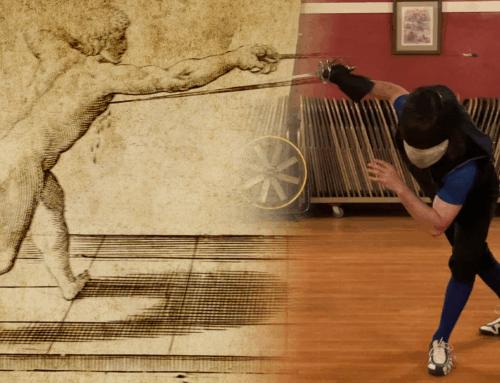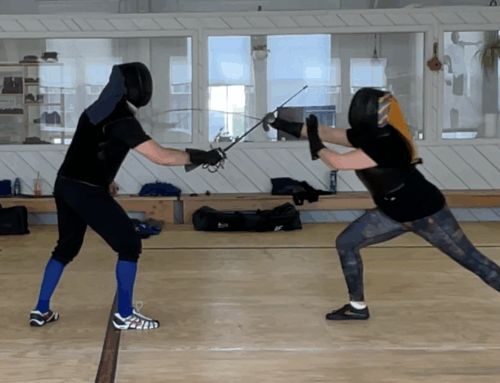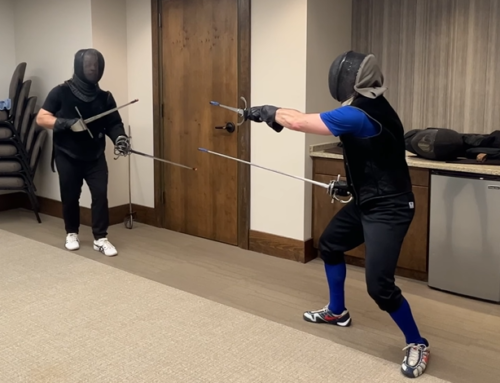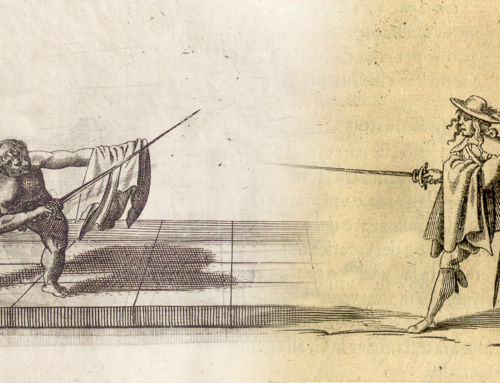Welcome back to measure (misura) month. We’re spending the entire month looking at the basics of this measure, your attack & defense options, and some sample play/actions from each measure.
Last week we looked at being Out of Measure and approaching into engagement. This week we’re looking at Misura Larghissima.
Historical Note & the Basics of Larghissima
It should be noted that Misura Larghissima isn’t a historical term found in any late-Renaissiance Italian manuals. It’s a term created by Devon Boorman at Academie Duello to fill the gap between being completely out of engagement and being in a lunge distance.
Historically, the Italian Masters would consider Larghissima still Out of Measure since you can’t strike your opponent with a firm-footed lunge. Despite it being a modern term, however, I find it a useful training tool for teaching modern practitioners.
Misura Larghissima means “widest measure” and is defined as the distance that you strike your opponent with a passing lunge or strike your opponent’s sword-arm with a step-lunge. It’s the space between being completely out of engagement and being able to strike your opponent’s head/torso with a step-lunge. Your blades are crossed, albeit weakly at the deboles (like in this blog’s hero image).
Larghissima & the True Fight

The True Fight is the aspect of fencing where you’re seeking control of your opponent’s weapon. You move forward if you have control and move back & seek control if you’ve lost control. There’s also no deceit (no feints) in the True Fight.
(I created a True Fight text-based game.
You can play Lvl 1 of the True Fight here.)
If our opponent…
- Retreats.
- Continue to find their blade and pursue
- Doesn’t move.
- Keep control of their blade and advance into Misura Larga
- Moves forward.
- Find their blade and hold your ground into Misura Larga
- Find their blade and also step forward into Misura Stretta
- If they take a big step forward, you can strike with a firm-footed step-lunge in Primo Tempo
Blade Actions & Responses from Larghissima
Blade actions from this distance is pretty simple. Whatever blade action your opponent does — be it a cavazione or a volte stabile — you counter with a cavazione.
Since you’re so far away from your opponent and weakly crossed at the debole, there’s no real strength in the weapon, so trying to resist lateral pressure is pointless.
Similarly, because we’re so far away, performing the cavazione is much faster. You can perform a cavazione in two ways:
- A small circular motion driven by your fingers
- By releasing and squeezing the grip of your sword.
I prefer for the former of the two in terza. The release/squeeze works best when in quarta, which is Alfieri’s preferred guard to cavazione in.
So if your opponent…
- Cavaziones. You perform a contracavazione (counter-disengage).
- Volta Stabiles (or presses into your sword). You perform a cavazione.
Striking From Larghissima
So we mentioned earlier that at this distance you can’t strike your opponent’s body with a firm-footed step lunge. So how can we hit our opponent from this distance? A few ways, fortunately… though they’re not the most ideal.
First, we can lunge and strike our opponent’s sword arm. From this distance it’s a relatively low risk, high reward shot. You’ll want to quickly recover and cover your opponent’s blade, however. This works best against a forward-minded fencer who’s seeking to control your weapon.
We also can bait our opponent to attack with a big action — like a very deep lunge or a passing lunge. This bait can be via stringere, an invitation, or a feint. As our opponent attacks we can parry & riposte via our own passing step/lunge (though we need to be faster than our opponent).
We also could beat their blade or perform an expulsion to get their point offline and then strike with a lunge or passing-lunge (depending on how much distance we need to make up). This is best against a forward-minded fencer who’s more eager to strike than control your weapon. They’re a bit more bold, impatient, or reckless.
You could, technically, strike your opponent with a passing lunge (see the image in the True Fight section) as they step forward from Out of Measure. However, this is a very long tempo action and is a high risk attack, so you need to move in perfect tempo and you need your opponent to give yourself a big enough tempo to move in (example: they advance with a passing step or a very big & slow advance).
In any case, trying to strike from this distance is pretty challenging and risky because of the distance one needs to cover, so baiting your opponent to attack and then striking in controtempo or dui tempi are your best bets.
Class Video
Here’s a recording of the class. It’s more or less what’s written out in this blog post, plus a strength/conditioning routine in the second half of the class.
DONATIONS: Classes are 100% free, however, if you find these sessions useful, please consider a small donation so I can continue to produce rapier & other historical martial arts content. Donate at https://www.paypal.me/thetavernknight








